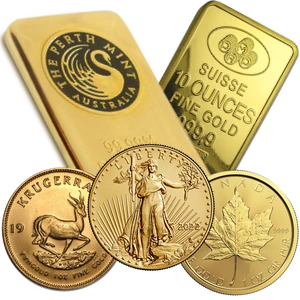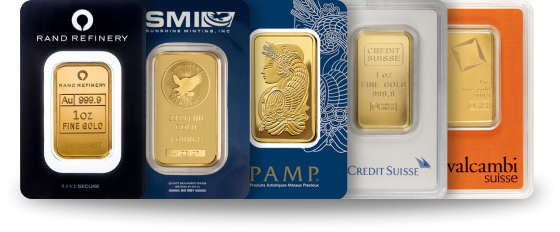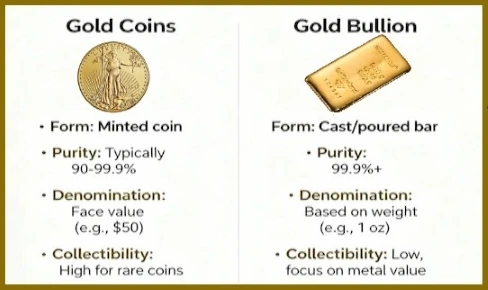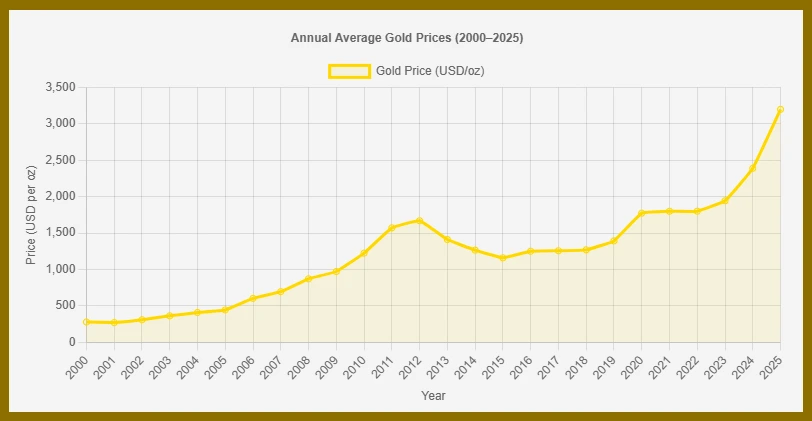Gold Coins vs. Gold Bullion: Which Shines Brighter Right Now?
Navigating the golden path to wealth preservation in today's uncertain economy
When markets get rocky and inflation remains stubborn, investors have traditionally turned to gold as a safe harbor. But if you're considering adding some golden glimmer to your portfolio today, you're faced with a key decision: should you buy gold coins or gold bullion?
Both options have their passionate advocates, and the right choice really depends on your personal financial goals, budget, and even your personality as an investor. Let's break down the differences in plain English, with an eye on current market trends.

Gold coins and bullion bars offer different advantages for today's investors
Gold Coins: Beauty with a Purpose
Gold coins are the celebrities of the precious metals world. Minted by government authorities like the U.S. Mint or Royal Canadian Mint, these pieces carry both intrinsic gold value and often significant collectible appeal.
Popular examples include the American Gold Eagle, Canadian Gold Maple Leaf, and South African Krugerrand. What makes coins particularly interesting right now is their dual nature as both investments and collectibles.

Government-minted gold coins like these are recognized worldwide
Why Investors Are Looking at Coins Now
With ongoing economic uncertainty driving demand for tangible assets, gold coins have maintained their popularity. Their smaller unit sizes make them accessible to everyday investors, and their recognizability provides peace of mind for those new to precious metals.
Current market observations show that premium collectible coins continue to perform well alongside generic bullion, particularly when investor sentiment is driven by both wealth preservation motives and collector interest.
Gold Bullion: Pure Value in Its Simplest Form
Gold bullion is gold in its most straightforward investment form—typically bars or ingots that are valued almost exclusively by weight and purity. Think of bullion as the "workhorse" of gold investing.
Common forms range from small 1-ounce bars that fit in the palm of your hand to hefty kilobars and larger. For investors focused purely on gold content with minimal extra costs, bullion often represents the most efficient option.

Bullion's Current Market Appeal
With ongoing inflation concerns, many institutional investors and high-net-worth individuals continue turning to larger bullion bars as an efficient inflation hedge. The lower premiums compared to coins mean more actual gold for your money.
We're currently seeing steady demand for smaller bullion bars (1oz to 10oz) from retail investors who want the cost efficiency of bullion but with the flexibility to sell portions of their holdings as needed.
Head-to-Head Comparison: Coins vs. Bullion Today
Cost & Premiums
Coins: Typically carry higher premiums over spot price (often 5-20% or more) due to minting costs, distribution, and collectibility factors.
Bullion: Generally has lower premiums (often 1-5% over spot), especially for larger bars.
Current Observation: With gold prices at elevated levels, many investors are opting for bullion to minimize premiums.
Liquidity & Recognition
Coins: Highly liquid, especially government-minted coins that are recognized worldwide. Their status as legal tender adds credibility.
Bullion: Also liquid, but larger bars may require authentication. Well-known refiner bars (like PAMP or Credit Suisse) trade easily.
Current Observation: Online marketplaces continue making both coins and small bullion bars easier to trade.
Storage Considerations
Coins: Compact and easy to store in home safes or safe deposit boxes. Their standardized sizes make storage straightforward.
Bullion: Larger bars require secure storage solutions. Professional vault storage adds to costs but provides peace of mind.
Current Observation: With safety concerns ongoing, allocated storage programs remain popular for both coins and bullion.
Value Beyond Gold Content
Coins: Can appreciate beyond gold price based on rarity, condition, and collector demand. This can work for or against you.
Bullion: Value tracks gold price almost exclusively. What you see is what you get.
Current Observation: Rare coin markets continue showing resilience during economic uncertainty, sometimes outperforming bullion.

Making Your Choice: Which Gold Is Right for You Now?
Consider Gold Coins If:
- You're a first-time gold investor wanting recognizable, easy-to-trade assets
- You appreciate the historical and artistic aspects of coinage
- You want the flexibility to sell small amounts if needed
- You're comfortable with potentially higher premiums for added collectibility
- You're interested in potential numismatic (collector) value appreciation
Consider Gold Bullion If:
- Your primary goal is maximum gold content for your money
- You're making a substantial investment and want cost efficiency
- You prefer the simplicity of valuation based purely on weight and purity
- You have access to secure storage for larger bars
- You're not interested in the collector market
The Balanced Approach Many Investors Take
Many seasoned investors don't choose one over the other—they build a diversified gold portfolio that includes both coins and bullion. This approach gives you the recognition and liquidity of coins alongside the cost efficiency of bullion.
A common strategy is to use bullion for the core of your gold holdings and add select coins for their additional benefits. This balanced approach remains popular as investors seek both safety and flexibility in uncertain times.
Current Market Considerations for Gold Investors
As we navigate today's economic landscape, several factors continue influencing the gold market:
- Inflation Concerns: With ongoing inflation worries, both coins and bullion maintain interest as traditional hedges.
- Central Bank Activity: Continued purchases by central banks worldwide continue supporting gold prices.
- Geopolitical Factors: Ongoing global tensions sustain safe-haven demand for physical gold.
- Accessibility Innovations: Platforms allowing fractional ownership of physical gold continue making both coins and bullion accessible to smaller investors.
- Economic Uncertainty: Mixed economic signals and market volatility keep gold relevant as a portfolio diversifier.

The Golden Bottom Line
Whether you choose gold coins, gold bullion, or a mix of both, you're making a move toward preserving your wealth in uncertain times. Coins offer recognition, liquidity, and collectibility, while bullion provides pure gold exposure with lower premiums.
The best choice depends on your individual circumstances: your investment goals, your budget, your storage options, and even your personal interests. In today's market, both have a place in a well-rounded precious metals strategy.
Remember, the shiniest portfolio is one that aligns with your financial goals and gives you peace of mind. Whichever path you choose, you're taking a tangible step toward financial security in an increasingly uncertain world.

 '
' 




